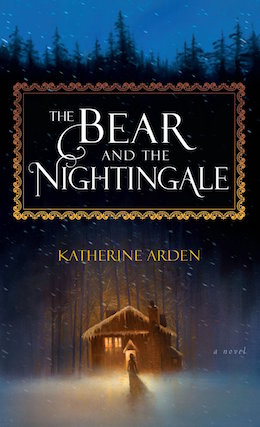I always find that the most enjoyable winter reads are the books that invoke a cold wind howling outside and a story being told next to a glowing fire. The Bear and the Nightingale casts a cozy spell, starting out with a once-upon-a-time told by the warm glow of a Russian oven. We listen along with a boyar’s brood of children as they are told of Morozko, the demon of winter, and the brave girls who face his cruelty to be granted his riches or die in the attempt.
But the tales told by the fire are more than folklore to Vasilisa, the boyar’s youngest child, who sees the domovoi who guards the hearth and the vazila in the stables. She charms the rusalka away from her murderous ways and makes sure that all the old spirits are held in balance to keep her home safe. Then her father brings home a new bride who can see the same spirits, but fears them as demons. Not long after, a priest arrives, ready to prey upon her fear and condemn Vasilisa and all those who hold with the old ways…
Soon the crops fail and the wolves circle close to the village, and people begin to call Vasilisa a witch, even as she tries to use her powers to protect them from an ancient evil. When a frost-eyed man seeks to claim her as his own, she must decide the price she is willing to pay to save her home.
Some spoilers ahead.
The strength of The Bear and the Nightingale lies in its evocation of life in the Russian wilderness, with its seasons, hardships, and beauties. We are given a vivid glimpse of a time gone by, and I found myself immersed in the dramas of the village and hearth. While I have no great expertise in Russian folklore, its use here feels true in spirit while adapting to the specific world of the narrative. This strong cultural backbone combines with fairytale prose and a stalwart heroine to make for an enjoyable read that would appeal to fans of Naomi Novik’s Uprooted.
It is therefore unfortunate to discover that the last quarter of the book does not quite deliver on this promise. Characters like Vasilisa’s brother Sasha who were introduced in the first act never reappear to influence the narrative, and others turn up relatively late but play critical roles. Vasilisa’s father and stepmother begin as complex characters with their own perspectives and desires, but in the end they are reduced to stock parts. The climax of the book escalates into a full-on physical battle which feels unprecedented by everything that has come before, and plot decisions and character developments veer down the path of least resistance rather than delving deeper into something more nuanced.
Then there is Vasilisa. It’s impossible not to cheer for her as she stomps through the book, first as a prickly, frog-mouthed child, then as a wild young girl, and finally as a witch come into her power. But when, at the ending, she sets out to see the world only to immediately go knocking on the frost king’s door, it feels a bit like a teenager declaring her independence and moving out, only to immediately shack up with her much older, slightly creepy boyfriend.
Despite the flaws of its ending, I would happily recommend The Bear and the Nightingale to fans of folkloric fantasy, as well as to anyone who likes their historical fiction with a healthy dose of magic.
The Bear and the Nightingale is available from Del Rey.
Caitlyn Paxson is a writer and storyteller. She is an editor at Goblin Fruit, and can sometimes be found discussing folklore and pop culture on the Fakelore Podcast or performing with the Banjo Apocalypse Crinoline Troubadours.










